| Listing 1 - 7 of 7 |
Sort by
|
Book
ISBN: 1400881250 Year: 2016 Publisher: Princeton, NJ : Princeton University Press,
Abstract | Keywords | Export | Availability | Bookmark
 Loading...
Loading...Choose an application
- Reference Manager
- EndNote
- RefWorks (Direct export to RefWorks)
This book introduces the theory of complex surfaces through a comprehensive look at finite covers of the projective plane branched along line arrangements. Paula Tretkoff emphasizes those finite covers that are free "ients of the complex two-dimensional ball. Tretkoff also includes background on the classical Gauss hypergeometric function of one variable, and a chapter on the Appell two-variable F1 hypergeometric function.The material in this book began as a set of lecture notes, taken by Tretkoff, of a course given by Friedrich Hirzebruch at ETH Zürich in 1996. The lecture notes were then considerably expanded by Hirzebruch and Tretkoff over a number of years. In this book, Tretkoff has expanded those notes even further, still stressing examples offered by finite covers of line arrangements. The book is largely self-contained and foundational material is introduced and explained as needed, but not treated in full detail. References to omitted material are provided for interested readers.Aimed at graduate students and researchers, this is an accessible account of a highly informative area of complex geometry.
Curves, Elliptic. --- Geometry, Algebraic. --- Projective planes. --- Unit ball. --- Riemann surfaces. --- Surfaces, Riemann --- Functions --- Ball, Unit --- Holomorphic functions --- Planes, Projective --- Geometry, Projective --- Algebraic geometry --- Geometry --- Elliptic curves --- Curves, Algebraic --- Appell hypergeometric function. --- Chern numbers. --- Euler number. --- Friedrich Hirzebruch. --- Gauss hypergeometric function. --- Gaussian curvature. --- Hermitian metric. --- Kodaira dimension. --- Mbius transformation. --- Miyaoka-Yau inequality. --- Riemann surface. --- Riemannian metric. --- algebraic geometry. --- algebraic surface. --- arithmetic monodromy group. --- b-space. --- ball "ient. --- canonical divisor class. --- complete quadrilateral. --- complex 2-ball. --- complex manifold. --- complex surface. --- covering group. --- covering space. --- differential geometry. --- divisor class group. --- divisor. --- elliptic curve. --- finite covering. --- first Chern class. --- fractional linear transformation. --- free 2-ball "ient. --- fundamental group. --- geometry. --- intersection point. --- line arrangement. --- line bundle. --- linear arrangement. --- log-canonical divisor. --- minimal surface. --- monodromy group. --- orbifold structure. --- orbifold. --- partial differential equation. --- plurigenus. --- projective plane. --- proportionality deviation. --- ramification indices. --- rational curve. --- regular point. --- signature. --- solution space. --- topological invariant. --- transversely intersecting divisor. --- triangle groups. --- weight.
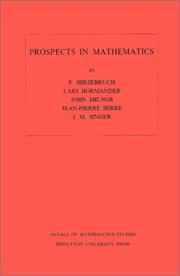
ISBN: 0691080941 9780691080949 1400881692 Year: 1971 Volume: 70 Publisher: Princeton
Abstract | Keywords | Export | Availability | Bookmark
 Loading...
Loading...Choose an application
- Reference Manager
- EndNote
- RefWorks (Direct export to RefWorks)
Five papers by distinguished American and European mathematicians describe some current trends in mathematics in the perspective of the recent past and in terms of expectations for the future. Among the subjects discussed are algebraic groups, quadratic forms, topological aspects of global analysis, variants of the index theorem, and partial differential equations.
Mathematics --- Mathématiques --- Congresses --- Congrès --- 51 --- -Math --- Science --- Congresses. --- -Mathematics --- 51 Mathematics --- -51 Mathematics --- Math --- Mathématiques --- Congrès --- A priori estimate. --- Addition. --- Additive group. --- Affine space. --- Algebraic geometry. --- Algebraic group. --- Atiyah–Singer index theorem. --- Bernoulli number. --- Boundary value problem. --- Bounded operator. --- C*-algebra. --- Canonical transformation. --- Cauchy problem. --- Characteristic class. --- Clifford algebra. --- Coefficient. --- Cohomology. --- Commutative property. --- Commutative ring. --- Complex manifold. --- Complex number. --- Complex vector bundle. --- Dedekind sum. --- Degenerate bilinear form. --- Diagram (category theory). --- Diffeomorphism. --- Differentiable manifold. --- Differential operator. --- Dimension (vector space). --- Ellipse. --- Elliptic operator. --- Equation. --- Euler characteristic. --- Euler number. --- Existence theorem. --- Exotic sphere. --- Finite difference. --- Finite group. --- Fourier integral operator. --- Fourier transform. --- Fourier. --- Fredholm operator. --- Hardy space. --- Hilbert space. --- Holomorphic vector bundle. --- Homogeneous coordinates. --- Homomorphism. --- Homotopy. --- Hyperbolic partial differential equation. --- Identity component. --- Integer. --- Integral transform. --- Isomorphism class. --- John Milnor. --- K-theory. --- Lebesgue measure. --- Line bundle. --- Local ring. --- Mathematics. --- Maximal ideal. --- Modular form. --- Module (mathematics). --- Monoid. --- Normal bundle. --- Number theory. --- Open set. --- Parametrix. --- Parity (mathematics). --- Partial differential equation. --- Piecewise linear manifold. --- Poisson bracket. --- Polynomial ring. --- Polynomial. --- Prime number. --- Principal part. --- Projective space. --- Pseudo-differential operator. --- Quadratic form. --- Rational variety. --- Real number. --- Reciprocity law. --- Resolution of singularities. --- Riemann–Roch theorem. --- Shift operator. --- Simply connected space. --- Special case. --- Square-integrable function. --- Subalgebra. --- Submanifold. --- Support (mathematics). --- Surjective function. --- Symmetric bilinear form. --- Symplectic vector space. --- Tangent space. --- Theorem. --- Topology. --- Variable (mathematics). --- Vector bundle. --- Vector space. --- Winding number. --- Mathematics - Congresses
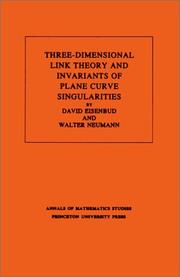
ISBN: 0691083819 0691083800 1400881927 9780691083810 9780691083803 Year: 1985 Volume: 110 Publisher: Princeton, N.J.
Abstract | Keywords | Export | Availability | Bookmark
 Loading...
Loading...Choose an application
- Reference Manager
- EndNote
- RefWorks (Direct export to RefWorks)
This book gives a new foundation for the theory of links in 3-space modeled on the modern developmentby Jaco, Shalen, Johannson, Thurston et al. of the theory of 3-manifolds. The basic construction is a method of obtaining any link by "splicing" links of the simplest kinds, namely those whose exteriors are Seifert fibered or hyperbolic. This approach to link theory is particularly attractive since most invariants of links are additive under splicing.Specially distinguished from this viewpoint is the class of links, none of whose splice components is hyperbolic. It includes all links constructed by cabling and connected sums, in particular all links of singularities of complex plane curves. One of the main contributions of this monograph is the calculation of invariants of these classes of links, such as the Alexander polynomials, monodromy, and Seifert forms.
Algebraic geometry --- Differential geometry. Global analysis --- Link theory. --- Curves, Plane. --- SINGULARITIES (Mathematics) --- Curves, Plane --- Invariants --- Link theory --- Singularities (Mathematics) --- Geometry, Algebraic --- Low-dimensional topology --- Piecewise linear topology --- Higher plane curves --- Plane curves --- Invariants. --- 3-sphere. --- Alexander Grothendieck. --- Alexander polynomial. --- Algebraic curve. --- Algebraic equation. --- Algebraic geometry. --- Algebraic surface. --- Algorithm. --- Ambient space. --- Analytic function. --- Approximation. --- Big O notation. --- Call graph. --- Cartesian coordinate system. --- Characteristic polynomial. --- Closed-form expression. --- Cohomology. --- Computation. --- Conjecture. --- Connected sum. --- Contradiction. --- Coprime integers. --- Corollary. --- Curve. --- Cyclic group. --- Determinant. --- Diagram (category theory). --- Diffeomorphism. --- Dimension. --- Disjoint union. --- Eigenvalues and eigenvectors. --- Equation. --- Equivalence class. --- Euler number. --- Existential quantification. --- Exterior (topology). --- Fiber bundle. --- Fibration. --- Foliation. --- Fundamental group. --- Geometry. --- Graph (discrete mathematics). --- Ground field. --- Homeomorphism. --- Homology sphere. --- Identity matrix. --- Integer matrix. --- Intersection form (4-manifold). --- Isolated point. --- Isolated singularity. --- Jordan normal form. --- Knot theory. --- Mathematical induction. --- Monodromy matrix. --- Monodromy. --- N-sphere. --- Natural transformation. --- Newton polygon. --- Newton's method. --- Normal (geometry). --- Notation. --- Pairwise. --- Parametrization. --- Plane curve. --- Polynomial. --- Power series. --- Projective plane. --- Puiseux series. --- Quantity. --- Rational function. --- Resolution of singularities. --- Riemann sphere. --- Riemann surface. --- Root of unity. --- Scientific notation. --- Seifert surface. --- Set (mathematics). --- Sign (mathematics). --- Solid torus. --- Special case. --- Stereographic projection. --- Submanifold. --- Summation. --- Theorem. --- Three-dimensional space (mathematics). --- Topology. --- Torus knot. --- Torus. --- Tubular neighborhood. --- Unit circle. --- Unit vector. --- Unknot. --- Variable (mathematics).
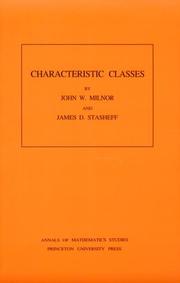
ISBN: 0691081220 9780691081229 140088182X Year: 1974 Volume: 76 Publisher: Princeton, N.J. Princeton University Press
Abstract | Keywords | Export | Availability | Bookmark
 Loading...
Loading...Choose an application
- Reference Manager
- EndNote
- RefWorks (Direct export to RefWorks)
The theory of characteristic classes provides a meeting ground for the various disciplines of differential topology, differential and algebraic geometry, cohomology, and fiber bundle theory. As such, it is a fundamental and an essential tool in the study of differentiable manifolds.In this volume, the authors provide a thorough introduction to characteristic classes, with detailed studies of Stiefel-Whitney classes, Chern classes, Pontrjagin classes, and the Euler class. Three appendices cover the basics of cohomology theory and the differential forms approach to characteristic classes, and provide an account of Bernoulli numbers.Based on lecture notes of John Milnor, which first appeared at Princeton University in 1957 and have been widely studied by graduate students of topology ever since, this published version has been completely revised and corrected.
Algebraic topology --- Characteristic classes --- Classes caractéristiques --- 515.16 --- #WWIS:d.d. Prof. L. Bouckaert/ALTO --- Classes, Characteristic --- Differential topology --- Topology of manifolds --- Characteristic classes. --- 515.16 Topology of manifolds --- Classes caractéristiques --- Additive group. --- Axiom. --- Basis (linear algebra). --- Boundary (topology). --- Bundle map. --- CW complex. --- Canonical map. --- Cap product. --- Cartesian product. --- Characteristic class. --- Charles Ehresmann. --- Chern class. --- Classifying space. --- Coefficient. --- Cohomology ring. --- Cohomology. --- Compact space. --- Complex dimension. --- Complex manifold. --- Complex vector bundle. --- Complexification. --- Computation. --- Conformal geometry. --- Continuous function. --- Coordinate space. --- Cross product. --- De Rham cohomology. --- Diffeomorphism. --- Differentiable manifold. --- Differential form. --- Differential operator. --- Dimension (vector space). --- Dimension. --- Direct sum. --- Directional derivative. --- Eilenberg–Steenrod axioms. --- Embedding. --- Equivalence class. --- Euler class. --- Euler number. --- Existence theorem. --- Existential quantification. --- Exterior (topology). --- Fiber bundle. --- Fundamental class. --- Fundamental group. --- General linear group. --- Grassmannian. --- Gysin sequence. --- Hausdorff space. --- Homeomorphism. --- Homology (mathematics). --- Homotopy. --- Identity element. --- Integer. --- Interior (topology). --- Isomorphism class. --- J-homomorphism. --- K-theory. --- Leibniz integral rule. --- Levi-Civita connection. --- Limit of a sequence. --- Linear map. --- Metric space. --- Natural number. --- Natural topology. --- Neighbourhood (mathematics). --- Normal bundle. --- Open set. --- Orthogonal complement. --- Orthogonal group. --- Orthonormal basis. --- Partition of unity. --- Permutation. --- Polynomial. --- Power series. --- Principal ideal domain. --- Projection (mathematics). --- Representation ring. --- Riemannian manifold. --- Sequence. --- Singular homology. --- Smoothness. --- Special case. --- Steenrod algebra. --- Stiefel–Whitney class. --- Subgroup. --- Subset. --- Symmetric function. --- Tangent bundle. --- Tensor product. --- Theorem. --- Thom space. --- Topological space. --- Topology. --- Unit disk. --- Unit vector. --- Variable (mathematics). --- Vector bundle. --- Vector space. --- Topologie differentielle --- Classes caracteristiques --- Classes et nombres caracteristiques
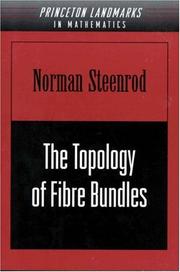
ISBN: 0691080550 0691005486 1400883873 9780691080550 Year: 1951 Volume: 14 Publisher: Princeton (N.J.): Princeton university press
Abstract | Keywords | Export | Availability | Bookmark
 Loading...
Loading...Choose an application
- Reference Manager
- EndNote
- RefWorks (Direct export to RefWorks)
Fibre bundles, now an integral part of differential geometry, are also of great importance in modern physics--such as in gauge theory. This book, a succinct introduction to the subject by renown mathematician Norman Steenrod, was the first to present the subject systematically. It begins with a general introduction to bundles, including such topics as differentiable manifolds and covering spaces. The author then provides brief surveys of advanced topics, such as homotopy theory and cohomology theory, before using them to study further properties of fibre bundles. The result is a classic and timeless work of great utility that will appeal to serious mathematicians and theoretical physicists alike.
#WWIS:d.d. Prof. L. Bouckaert/ALTO --- 515.1 --- 515.1 Topology --- Topology --- Topology. --- Analysis situs --- Position analysis --- Rubber-sheet geometry --- Geometry --- Polyhedra --- Set theory --- Algebras, Linear --- Algebraic topology. --- Associated bundle. --- Associative algebra. --- Associative property. --- Atlas (topology). --- Automorphism. --- Axiomatic system. --- Barycentric subdivision. --- Bilinear map. --- Bundle map. --- Classification theorem. --- Coefficient. --- Cohomology ring. --- Cohomology. --- Conjugacy class. --- Connected component (graph theory). --- Connected space. --- Coordinate system. --- Coset. --- Cup product. --- Cyclic group. --- Determinant. --- Differentiable manifold. --- Differential structure. --- Dimension (vector space). --- Direct product. --- Division algebra. --- Equivalence class. --- Equivalence relation. --- Euler number. --- Existence theorem. --- Existential quantification. --- Factorization. --- Fiber bundle. --- Frenet–Serret formulas. --- Gram–Schmidt process. --- Group theory. --- Homeomorphism. --- Homology (mathematics). --- Homomorphism. --- Homotopy group. --- Homotopy. --- Hopf theorem. --- Hurewicz theorem. --- Identity element. --- Inclusion map. --- Inner automorphism. --- Invariant subspace. --- Invertible matrix. --- Jacobian matrix and determinant. --- Klein bottle. --- Lattice of subgroups. --- Lie group. --- Line element. --- Line segment. --- Linear map. --- Linear space (geometry). --- Linear subspace. --- Manifold. --- Mapping cylinder. --- Metric tensor. --- N-sphere. --- Natural topology. --- Octonion. --- Open set. --- Orientability. --- Orthogonal group. --- Orthogonalization. --- Permutation. --- Principal bundle. --- Product topology. --- Quadratic form. --- Quaternion. --- Retract. --- Separable space. --- Set theory. --- Simplicial complex. --- Special case. --- Stiefel manifold. --- Subalgebra. --- Subbase. --- Subgroup. --- Subset. --- Symmetric tensor. --- Tangent bundle. --- Tangent space. --- Tangent vector. --- Tensor field. --- Tensor. --- Theorem. --- Tietze extension theorem. --- Topological group. --- Topological space. --- Transitive relation. --- Transpose. --- Union (set theory). --- Unit sphere. --- Universal bundle. --- Vector field.
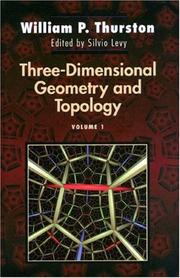
ISBN: 0691083045 1400865328 9780691083049 Year: 1997 Volume: 35. Publisher: Princeton, N.J. Princeton University
Abstract | Keywords | Export | Availability | Bookmark
 Loading...
Loading...Choose an application
- Reference Manager
- EndNote
- RefWorks (Direct export to RefWorks)
This book develops some of the extraordinary richness, beauty, and power of geometry in two and three dimensions, and the strong connection of geometry with topology. Hyperbolic geometry is the star. A strong effort has been made to convey not just denatured formal reasoning (definitions, theorems, and proofs), but a living feeling for the subject. There are many figures, examples, and exercises of varying difficulty.
Topology --- Differential geometry. Global analysis --- Geometry, Hyperbolic --- Three-manifolds (Topology) --- Géométrie hyperbolique --- Variétés topologiques à 3 dimensions --- Geometry, Hyperbolic. --- 514.1 --- 3-manifolds (Topology) --- Manifolds, Three dimensional (Topology) --- Three-dimensional manifolds (Topology) --- Low-dimensional topology --- Topological manifolds --- Hyperbolic geometry --- Lobachevski geometry --- Lobatschevski geometry --- Geometry, Non-Euclidean --- General geometry --- Three-manifolds (Topology). --- 514.1 General geometry --- Géométrie hyperbolique --- Variétés topologiques à 3 dimensions --- 3-sphere. --- Abelian group. --- Affine space. --- Affine transformation. --- Atlas (topology). --- Automorphism. --- Basis (linear algebra). --- Bounded set (topological vector space). --- Brouwer fixed-point theorem. --- Cartesian coordinate system. --- Characterization (mathematics). --- Compactification (mathematics). --- Conformal map. --- Contact geometry. --- Curvature. --- Cut locus (Riemannian manifold). --- Diagram (category theory). --- Diffeomorphism. --- Differentiable manifold. --- Dimension (vector space). --- Dimension. --- Disk (mathematics). --- Divisor (algebraic geometry). --- Dodecahedron. --- Eigenvalues and eigenvectors. --- Embedding. --- Euclidean space. --- Euler number. --- Exterior (topology). --- Facet (geometry). --- Fiber bundle. --- Foliation. --- Fundamental group. --- Gaussian curvature. --- Geometry. --- Group homomorphism. --- Half-space (geometry). --- Holonomy. --- Homeomorphism. --- Homotopy. --- Horocycle. --- Hyperbolic geometry. --- Hyperbolic manifold. --- Hyperbolic space. --- Hyperboloid model. --- Interior (topology). --- Intersection (set theory). --- Isometry group. --- Isometry. --- Jordan curve theorem. --- Lefschetz fixed-point theorem. --- Lie algebra. --- Lie group. --- Line (geometry). --- Linear map. --- Linearization. --- Manifold. --- Mathematical induction. --- Metric space. --- Moduli space. --- Möbius transformation. --- Norm (mathematics). --- Pair of pants (mathematics). --- Piecewise linear manifold. --- Piecewise linear. --- Poincaré disk model. --- Polyhedron. --- Projection (linear algebra). --- Projection (mathematics). --- Pseudogroup. --- Pullback (category theory). --- Quasi-isometry. --- Quotient space (topology). --- Riemann mapping theorem. --- Riemann surface. --- Riemannian manifold. --- Sheaf (mathematics). --- Sign (mathematics). --- Simplicial complex. --- Simply connected space. --- Special linear group. --- Stokes' theorem. --- Subgroup. --- Subset. --- Tangent space. --- Tangent vector. --- Tetrahedron. --- Theorem. --- Three-dimensional space (mathematics). --- Topological group. --- Topological manifold. --- Topological space. --- Topology. --- Transversal (geometry). --- Two-dimensional space. --- Uniformization theorem. --- Unit sphere. --- Variable (mathematics). --- Vector bundle. --- Vector field. --- Topologie algébrique --- Topologie combinatoire --- Algebraic topology. --- Combinatorial topology. --- Variétés topologiques --- Geometrie --- Theorie des noeuds
Book
ISBN: 303921621X 3039216201 Year: 2019 Publisher: MDPI - Multidisciplinary Digital Publishing Institute
Abstract | Keywords | Export | Availability | Bookmark
 Loading...
Loading...Choose an application
- Reference Manager
- EndNote
- RefWorks (Direct export to RefWorks)
This Special Issue presents research papers on various topics within many different branches of mathematics, applied mathematics, and mathematical physics. Each paper presents mathematical theories, methods, and their application based on current and recently developed symmetric polynomials. Also, each one aims to provide the full understanding of current research problems, theories, and applications on the chosen topics and includes the most recent advances made in the area of symmetric functions and polynomials.
generalized Laguerre --- central complete Bell numbers --- rational polynomials --- Changhee polynomials of type two --- Euler polynomials --- generalized Laguerre polynomials --- Hermite --- conjecture --- Legendre --- the degenerate gamma function --- trivariate Lucas polynomials --- perfectly matched layer --- third-order character --- Euler numbers --- two variable q-Berstein operator --- entropy production --- hypergeometric function --- q-Bernoulli numbers --- q-Bernoulli polynomials --- symmetry group --- Bernoulli polynomials --- Fibonacci polynomials --- central incomplete Bell polynomials --- Chebyshev polynomials --- convolution sums --- Lucas polynomials --- Jacobi --- the modified degenerate Laplace transform --- q-Volkenborn integral on ?p --- and fourth kinds --- two variable q-Berstein polynomial --- the modified degenerate gamma function --- two variable q-Bernstein operators --- reduction method --- identity --- elementary and combinatorial methods --- generalized Bernoulli polynomials and numbers attached to a Dirichlet character ? --- explicit relations --- recursive sequence --- Fubini polynomials --- p-adic integral on ?p --- generating functions --- q-Euler number --- acoustic wave equation --- congruence --- trivariate Fibonacci polynomials --- stochastic thermodynamics --- fermionic p-adic integrals --- Laguerre polynomials --- fluctuation theorem --- Bernoulli numbers and polynomials --- w-torsion Fubini polynomials --- non-equilibrium free energy --- hypergeometric functions 1F1 and 2F1 --- recursive formula --- Chebyshev polynomials of the first --- second --- central complete Bell polynomials --- Apostol-type Frobenius–Euler polynomials --- sums of finite products --- q-Euler polynomial --- symmetric identities --- stability --- fermionic p-adic q-integral on ?p --- Gegenbauer polynomials --- continued fraction --- thermodynamics of information --- well-posedness --- fermionic p-adic integral on ?p --- catalan numbers --- classical Gauss sums --- three-variable Hermite polynomials --- q-Changhee polynomials --- Catalan numbers --- two variable q-Bernstein polynomials --- q-Euler polynomials --- analytic method --- representation --- mutual information --- Fibonacci --- Legendre polynomials --- Gegenbauer --- generalized Bernoulli polynomials and numbers of arbitrary complex order --- Lucas --- elementary method --- new sequence --- third --- the degenerate Laplace transform --- computational formula --- operational connection --- sums of finite products of Chebyshev polynomials of the third and fourth kinds --- Changhee polynomials --- linear form in logarithms
| Listing 1 - 7 of 7 |
Sort by
|

 Search
Search Feedback
Feedback About UniCat
About UniCat  Help
Help News
News